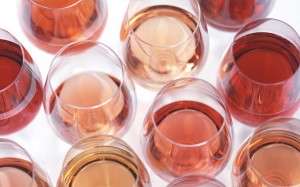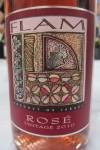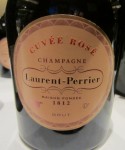
#219 – June 26, 2012
The birth last week of our beautiful daughter Ariella Naomi seemed like a perfect excuse for my annual newsletter on the delights of the most refreshing and summery of wines – the goddess of goodness – Rosé. Rosé is a tremendously underappreciated wine that goes well with an incredible array of food with the ability to provide welcome respite from the uncomfortable heat wave of the past week (Ayala is pretty happy not to be pregnant for the remainder of this summer). With all due respect to Eric Asimov, while I do sometimes enjoy Rosé during the year Rosé is and always will be the perennial summer wine for me.
As someone who revels in the continuous proliferation of great kosher options for the budding wine lover, I enjoy most varietals and many wine making styles as long as they are well done. However with all that said, during the scorching summer months I find myself reaching for Rosé more often than many of the other fantastic heat-busting available delights such as Viognier, Sauvignon Blanc or even sparkling wines (all of whom provide delightful respite from the terrors of a New York City July or August). With a beautiful pink color, tons of fresh and tart berry fruits, a typically low(er) alcohol content and crisp refreshing acidity, it’s the perfect summer beverage best enjoyed out of doors and well chilled. In my opinion, it also happens to be a wine insanely well suited to the Mediterranean climate and fare, making it another candidate for marketing good Israeli / Mediterranean wines. Added bonuses include a typically low price and extreme versatility, making it a delicious match to most foods (although three recent options are outside the low-priced genre at around $30 a bottle). As you will see from the tasting notes below, Rosé can and is made from almost any red grape including Barbera, Carignan, Syrah, Cabernet Sauvignon, Cabernet Franc and Sangiovese with the more interesting versions coming from Syrah, Zinfandel, Grenache and Mourvèdre.
Rosé (French for pink) is used to describe the wines that fall into the color spectrum between red and white and are produced in a number of different ways. One method of producing Rosé is maceration in which, following crush, the [white] juice of red grapes is allowed to have minimal contact with the grape skins (typically a few hours to a few days) before they are discarded (the longer the contact with the skins the darker in color (and the more full-bodied and tannic) the wine will be). Given the limited contact with the skins, almost no tannins are imparted into the juice allowing the wine to be enjoyed well chilled (see my wine-serving temperature newsletter for the chilling effect on tannin).
Another common method is known as the Saignée method that is a byproduct of making red wine in which the wine maker “bleeds the vats”. If a wine maker desires to increase the intensity of a red wine, they may drain some of the pink juice prior to fermentation resulting in a higher concentration of red juice and a more intensely flavored wine. The drained pink juice is fermented as a separate wine giving us Rosé.
Another, far less common method that usually results in inferior wines, is blending red and white wines which is really only utilized in Champagne where Pinot Noir is added to a Champagne base to create the sexiest of all wines – Rosé Champagne. Another, less common, method is via maceration, in which the Pinot Noir grapes are allowed [very] brief skin contact during fermentation (the methodology utilized for the Laurent Perrier below).
In the United State Rosé is also referred to as blush or White X, with X being replaced by the grape from which the wine in question is produced. An example would be White Zinfandel that, for some unfathomable reason, tends to be a pretty popular wine but remains a wine you should never ever drink. If there were ever a wine that could compete with Bartanura’s Moscato d’Asti for my hatred – White Zinfandel would be at the top of the list (and several rungs above any other potential competitor). Besides its general inferiority, most White Zinfandel wines have an unpleasant bubble gum flavor and almost every kosher version is a poster child for the reason plenty of uninformed folks still think all kosher wines are terrible. According to Jeff Morgan, the postwar popularity of White Zinfandel in the United States is a deciding factor in the disdain many oenophiles have for Rosé. Now, if only Jeff, a renowned expert on Rosé, would add a crisp refreshing Provence-style Rosé to his repertoire we’d be all set! While not set in stone, blush wines are usually those on the slightly sweeter side as opposed to dry and crisp Rosé wines.
As noted above, one of the best things about Rosé is its deliciousness chilled, providing substantial assistance in assuaging the exhausting effect of the heat and humidity. I try to serve Rosé at about 46-50ºF (8-10ºC) – slightly colder than its optimum drinking temperature, which allows the wine to warm up ever so slightly on the table or in your glass as opposed to suffering a too-warm Rosé – never a pleasant experience. Coupled with its relatively low alcohol and extreme food-pairing versatility, Rosé is the quintessential picnic and/or brunch wine, matching beautifully with omelets, chicken salad, fried and lightly grilled fish and most of the other lighter fare which I find myself enjoying as the mercury starts skyrocketing.
While many prefer a little fruit and residual sugar in their Rosé, my personal preference is for exceedingly dry and crisp – a tough wine to find, especially in the kosher world where most Rosé wines are a little fruitier than I like (thankfully this is changing). For many years my favorite Rosé was Tabor’s, made from Cabernet Franc grapes. With this wine apparently no longer being made, I have found the delightful Agur Rosa a decent replacement but it is only sold in Israel. Both Flam and Castel make great versions but they retail for over $30, which, while “worth it”, makes them less than YH Best Buys. My go-to Rosé used to be the Recanati version, but for some unfathomable reason, they are still pushing the 2010 vintage even though it is already a bit the hill, with the 2011 version not expected until August.
Despite Rosé wines unfortunately not being as common in US wine shops as I would like, the kosher consumer’s surging interest in quality wine has effected the world of Rosé as well with new and better versions being introduced on a regular basis. Some of the blame for Rosé’s lack of popularity may lie with the wineries, for which, in many cases, Rosé is either an after-thought or dumping ground for inferior red grapes. While Rosé is inexpensive to make it also has a low profit margin resulting in wineries not investing any serious time or effort. Granted, with the exception of a few Rosé Champagnes, there has never been a “great” Rosé wine and probably never will be, but that doesn’t ever excuse a lackluster effort. In recent years, Israel has seen an increase in the world of Rosé, both qualitatively and quantitatively. To that end, over the last few weeks, I sourced a nice bunch of Rosé wines, most of which I enjoyed and some of which are described below.
Two last things to keep in mind when plunking down for a Rosé: similar to white wines, Rosé wines are meant to be drunk as close to release as possible so always look for the most recent vintage year as they lose their bright, fresh flavors quickly and Rosé is not a wine to be taken seriously – they are meant to be fun – so chill, relax and enjoy!
Castel, Rosé, 2011: Following on the great success of their 2009 Rosé, this year’s version, while different than the 2009 vintage [resulting from a different wine making process], is truly delicious and provides the Israeli wine scene with something it has been lacking – a crisply dry and refreshing Rosé with enough depth and complexity to make it more than a refreshing summer quaffer (although, price aside, it excels in that department as well). A blend of 60% Merlot, 20% Cabernet Franc and 20% Malbec (slightly unripe fruit that was cold-fermented). A rich nose of red fruit including strawberries, raspberries and red grapefruit with much of the same on the slightly viscous palate where some pleasing minerality creeps in, coupled with judicious acidity that keeps the fruit in check and makes for great food pairing, all leading into a lingering and slightly bitter finish. Its only Achilles Heel is price (at $30 it’s a tad expensive for a Rosé), a common problem for Israeli wines.
 Flam, Rosé, 2010: Made from 100% Cabernet Franc grapes and coupled with the incredible pedigree of the winery, I was sold on this wine before I took my first delightful sip. A rich and ripe nose loaded with strawberry, tart raspberries, pleasing citrus notes, hints of minerals and blooming flowers. The medium bodied palate has much of the same with bright acidity, more lively fruit and minerals. Well made with great balance, this is a delightful wine that is great with food or on its own.
Flam, Rosé, 2010: Made from 100% Cabernet Franc grapes and coupled with the incredible pedigree of the winery, I was sold on this wine before I took my first delightful sip. A rich and ripe nose loaded with strawberry, tart raspberries, pleasing citrus notes, hints of minerals and blooming flowers. The medium bodied palate has much of the same with bright acidity, more lively fruit and minerals. Well made with great balance, this is a delightful wine that is great with food or on its own.
Dalton, Rosé, 2011: A light, easy-drinking and refreshing wine made from a blend of Barbera, Zinfandel with a bit of Cabernet Sauvignon thrown in for good measure. Fermentation was stopped early to retain a bit of residual sugar that, while more than I personally prefer, makes this refreshing quaffer quite accessible to all, including newbie drinkers. More pleasurable on its own as a refreshing aperitif than with food, with great QPR and enough refreshing acidity to keep the fruit and residual sugar in check, this is a terrific summer pleaser. Bright strawberries, cherries, hint of rose petals and lemons on both the nose and palate. While most Rosé wines are not meant for sophistication, this wine is pure fun – an easy date!
![]() Galil Mountain, Rosé, 2011: While the Yiron remains one of Israel’s best QPR wines and I love the Meron as well, in recent years some of the wineries lower-tiered options have declined a bit in quality and they are no longer the best Israeli option for well-made entry-level wines. That said, this Rosé is a bright and cheerful wine, made for easy and relaxed drinking. Concocted from a smorgasbord of 75% Sangiovese, 13 % Barbera, 10% Pinot Noir, and 2% Syrah, this is perfect for a picnic and very well priced. Plenty of strawberries, tart red berries and plenty of heathery citrus notes, the wine is almost as dry as I like it with plenty of acidity to keep it fresh on your palate, regardless of how high temperatures rise. A slightly bitter finish rounds out this wine and gives it some pleasing bite.
Galil Mountain, Rosé, 2011: While the Yiron remains one of Israel’s best QPR wines and I love the Meron as well, in recent years some of the wineries lower-tiered options have declined a bit in quality and they are no longer the best Israeli option for well-made entry-level wines. That said, this Rosé is a bright and cheerful wine, made for easy and relaxed drinking. Concocted from a smorgasbord of 75% Sangiovese, 13 % Barbera, 10% Pinot Noir, and 2% Syrah, this is perfect for a picnic and very well priced. Plenty of strawberries, tart red berries and plenty of heathery citrus notes, the wine is almost as dry as I like it with plenty of acidity to keep it fresh on your palate, regardless of how high temperatures rise. A slightly bitter finish rounds out this wine and gives it some pleasing bite.
 Laurent Perrier, Rosé Brut, n.v.: The only kosher Rosé Champagne made by a “real” Champagne House and a delicious treat (especially as it combines Rosé and Champagne – two of my favorite things). Less obligatory and more romantic (and expensive) than regular Champagne, Rosé Champagne has exploded in popularity over the last decade with more and more Champagne Houses trying their hands at producing this lucrative wine. This version is made from 100% Pinot Noir grapes and, as with most Rosé wines, is pretty light on the palate. Loaded with typical yeast, toasted bread and green apple flavors, these accompanied by lush strawberries, cherries and hints of slightly astringent citrus. This is a fun (albeit expensive fun) wine and a great accompaniment to any summer festivities. A real treat!
Laurent Perrier, Rosé Brut, n.v.: The only kosher Rosé Champagne made by a “real” Champagne House and a delicious treat (especially as it combines Rosé and Champagne – two of my favorite things). Less obligatory and more romantic (and expensive) than regular Champagne, Rosé Champagne has exploded in popularity over the last decade with more and more Champagne Houses trying their hands at producing this lucrative wine. This version is made from 100% Pinot Noir grapes and, as with most Rosé wines, is pretty light on the palate. Loaded with typical yeast, toasted bread and green apple flavors, these accompanied by lush strawberries, cherries and hints of slightly astringent citrus. This is a fun (albeit expensive fun) wine and a great accompaniment to any summer festivities. A real treat!
Domaine Netofa, Rosé, Galilee, 2011: Pierre Miodownick continues the winery’s successes with this delightfully refreshing wine. An easy drinking blend of Syrah and Mourvèdre, with plenty of bright fruit and crisp acidity, combining to provide a perfect summer quaffer. A beautiful nose, redolent of stone fruit, strawberries, a hint of watermelon and nice minerals lead into a light to medium bodied palate with more fruit, citrus and mineral and nicely lingering finish with some pleasing bitterness.